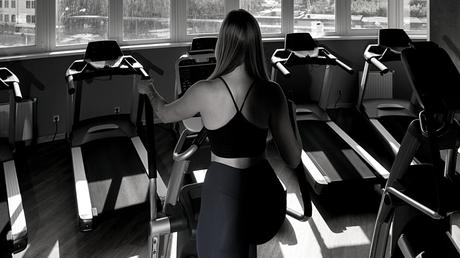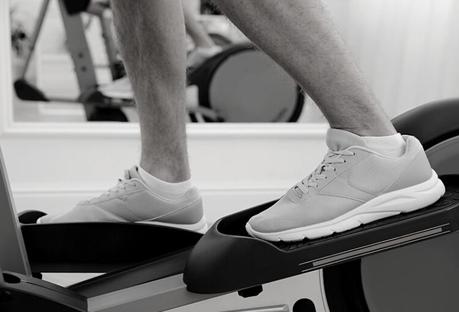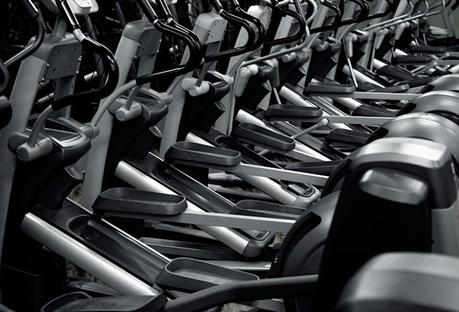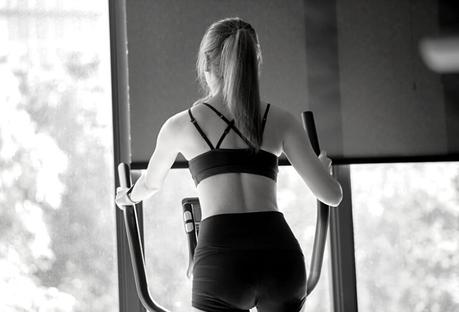Going backward on the elliptical is a great way to mix up your cardio workouts. Here’s how to do it, the benefits of going backward on the elliptical, muscles worked, and more.

Elliptical training is one of the best ways to take your cardio to the next level while also building muscle—not just in your legs, but in your core and upper body, too.
Plus, you can burn an awesome number of calories over the course of your workout and improve your balance, coordination, and agility in the process.
Now that’s a workout you can love!
One of the best benefits of the elliptical trainer is that you can adapt it to a wide range of workouts, everything from HIIT training to sprint training to muscle-focused exercise.
And, if you’re smart, even just switching directions and pedaling backward can make a huge difference in the way your body is trained.
Muscles Worked When Going Backwards on the Elliptical
It’s fairly uncommon to see people pedaling backward on the elliptical machine; after all, we learn to pedal the “normal” way (forward), and it just doesn’t occur to most of us to even think about pedaling backward.
But breaking that mindset and learning to pedal backward can actually be hugely beneficial.

I’ll share some of the main benefits below, but first I want to take a moment to examine how this small adaptation in your training can target your muscles in a new way.
When you look at the muscles worked on the elliptical machine, you’ll find there’s focus on pretty much every muscle in the body:
- Your chest, triceps, shoulders, and forearms engage in the “push” part of the exercise
- Your back, biceps, shoulders, and forearms engage in the “pull” part of the exercise
- Your obliques, spinal muscles, and abs engage to move your upper and lower halves in sync with each other
- Your quads, hamstrings, glutes, and calves all work together to support your weight and enable you to pedal
These muscles are engaged whether you pedal forward or backward. It’s just the way the elliptical works, and it gives you a full-body workout in either direction.
The Importance of Stride Length: Wondering how to properly size stride length on the elliptical? Check out this guide on how to choose the best elliptical stride length.
Where you’ll really notice the change is specifically in your leg muscles.
When you stride forward, the leg muscle that activates the most is the biceps femoris, also known as the hamstring. Your glutes, calves, and quads all work, too, but the hamstrings are most active with the regular stride.
However, when you switch directions, hamstring engagement decreases and it’s the quads that really take over.
The leg muscle that activates the most with the backward stride is the rectus femoris, the uppermost of your four quad muscles.
The calves engage equally with both forward and backward striding, so there’s no huge change there.
Really, the largest difference is the switch between the posterior and anterior muscle focus.
Fun Fact: To increase glute engagement, you simply need to raise the incline/grade, regardless of the direction pedaled.
With backward striding, it’s all about those quads. The emphasis is placed on your quads, hammering them harder with every step.
For forward striding, your hamstrings do more of the work, which helps to strengthen the posterior chain muscles that serve as antagonist to your quads.
Ultimately, both types of training are crucial for developing strong legs and be used interchangeably for a more balanced leg workout.
The Benefits of Going Backwards on the Elliptical Machine
Now that you understand how the change in direction shifts the focus, I want to take a few minutes to talk about the benefits of pedaling on the elliptical backward rather than simply keeping the “normal” forward pedal.
You’ll be surprised to find there are some specific benefits you can obtain from this change of direction:
More Quad Focus
Most of us already pay our quads a lot of attention on Leg Day training sessions. Squats, lunges, leg presses, leg extensions, and most of the other leg-focused “big lifts” hammer the quads, with less glute and hamstring engagement.
It’s a good thing that the elliptical engages the hamstrings more (and glutes, with sufficient incline) in order to strengthen the posterior muscles that work with the quads to stabilize the legs.
But there’s one specific benefit to training using backward pedaling: it’s great for strengthening your knees.
Fun Fact: Studies have shown that walking backward can increase your knee range of motion, decrease knee strain, reduce knee pain and swelling, and strengthen the muscles surrounding the knees to protect them against injury or impact.
For those with knee pain, walking backward is an excellent way to address one of your greatest insufficiencies and “bulletproof” your knees against future pain or injuries.
Better Running Strength
Running is considered one of the best forms of exercise to determine fitness. Simply put, being able to run for longer and/or faster typically means you’re fitter.
Thus, a lot of the training we do in the gym is intended to help us run more.
Fun Fact: Surprisingly, as you’ll see in my elliptical vs running article, elliptical training actually burns more calories than a steady-state jog or slow-pace run.
Running is a high-impact exercise that can put a lot of strain on your knees, causing knee pain and injuries.
Using backward walking on the elliptical (just like on the treadmill) can help to strengthen your knees and protect them against injuries.
But backward walking on the elliptical will also strengthen the quad muscles that play a significant role in your ability to run.
Because you’re training for both strength and endurance, you’ll find your leg muscles are able to support the strain of your run longer, and you will have the strength to run faster, too.

More Calories Burned
If you compare the calories burned on the elliptical machine to just about any other cardio machine in the gym, the elliptical wins hands down.
That’s what makes it one of the best cardio machines for weight loss and fat burning!
The cool thing about pedaling backwards is that you actually burn even more calories than you would pedaling forward. Your quad muscles are larger than your hamstring muscles, meaning they consume more energy as you use them.
The calorie increase is fractional, but over the course of an hour or so, you’ll notice a significant increase in calorie expenditure thanks to your pedaling backward.
Hit HIIT Harder
Last, but definitely not least, you’ll find that doing your elliptical trainer HIIT workout while pedaling backward feels a lot harder than pedaling forward!
It’s all the way that our brains work: we’re so accustomed to pedaling forward that reversing direction actually takes some cognitive effort to adapt to.
Over the course of your full HIIT workout (or any workout), your mind will have to work a bit harder to keep pedaling backward.
Add in the intensity of the HIIT workout itself, and you’ll walk away from your training session sweating bullets and feeling like a million bucks—all while training your body in a new way and burning more calories.
The elliptical is already one of the best HIIT machines in the gym, but adding in the element of pedaling backward just steps it up a notch!
How to Go Backwards on the Elliptical
The actual “how” of going backward on the elliptical is actually fairly easy.
Really, all you have to do is step on the machine, grip the handles, but instead of striding forward like you’re used to, start walking backwards.

It’ll take a few minutes to really get the hang of the movement, which will feel odd or even “wrong” at first. But by the end of your training session, it will feel as natural as forward walking.
To incorporate backward pedaling into your elliptical workouts:
- Start walking forward, and switch up halfway into your workout. This way, you get the focus on both the hamstrings and quads, and you get an easy-to-perform workout while also strengthening your knees.
- Walk backward the entire time. Every other training session, switch up to walking backward. That way, you’ll get one session more hamstring-focused, the other paying greater attention to your quads.
- Switch it up and HIIT it hard. If you’re doing HIIT workouts, try mixing it up. Spend the first 5 minutes pedaling forward, then the next 5 minutes backward. Repeat that for 20 to 30 minutes, training 5 minutes in each direction, and you’ll walk away confident you gave all of your leg muscles a killer workout.
See?
Nice and easy to add to any training program!
Backward on the Elliptical — FAQs
Does going backward on the elliptical work the glutes?
Going backward on the elliptical pays more attention to the quads. To emphasize the glutes more, raise the incline and, for good measure, increase the intensity.
The higher the incline, the harder your glutes have to work to push down on the pedal from an elevated angle (like climbing very tall stairs), and the stronger they become.
How often should you go backward on the elliptical?
There is no such thing as “too often” when it comes to backward pedaling on the elliptical. Just like you’d pedal forward daily, every other day, or a few times a week, you can do the same with backward pedaling.
The only thing that changes is how your body moves through the pedaling, which muscles receive more attention, and how your stabilizer muscles adapt to the odd sensation of backward pedaling.
But feel free to incorporate backward pedaling into every elliptical training session!
The Bottom Line
I love how one small change to your workout can lead to drastically different (and positive) outcomes.
Something as minor as changing the direction of your movement will not only change up the muscles targeted, but engage your body overall in a new and unusual way that will force you to adapt and improve.
Ultimately, pedaling backward can have some awesome benefits—as you saw above—but the change is minor enough that it won’t interfere with the true purpose of your workout: burning calories and building muscular endurance.
I highly recommend using the elliptical machine backward at least 25% of the time, but you can do as much as you want, depending on what muscles you feel need more focus.
More Elliptical Machine Guides and Articles
How Much Do Ellipticals Cost? (44 Different Models Compared). Ellipticals can be a costly investment in your workout goals. Here is a look at how much each type of elliptical costs and how much to spend on one.
How to Lose Weight Fast on the Elliptical (Plus Benefits and Sample Fat-Burning Workouts). Ready to unlock beast mode on your fat-burning goals? Here’s how to use the elliptical trainer the right way for weight loss, including some pro tips to max out fat burning, and three workouts to get you started.
Sole E95 Elliptical Trainer Review | The Best Elliptical Ever for Home Gyms? Wondering if the Sole E95 Elliptical is the right one for you? In this guide, we do a deep dive on this popular elliptical trainer, looking at the pros, cons, and how it compares to other ellipticals for home gyms.
